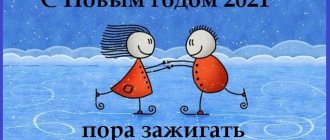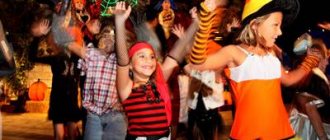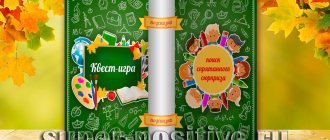Dance games are not just a dance and not just a music game. This is the energy of free movement to music, combined with the excitement of team play. It's always fun, it lifts the mood of the participants, adds good emotions and allows them to cope with bad ones. All children take part in dance games with pleasure. Dance games are popular for all ages, starting from matinees in kindergarten, and... perhaps there is no upper age limit, because even adults enjoy participating in competitions at various events. But still, the music, rules, and movements in dance games for children are different. We offer a selection of dance games for children of different ages. Where and to whom can these games be useful? Animators, educators, teachers and parents
- At themed matinees,
- Summer on the beach
- On the New Year's tree,
- At a children's camp
- Even on the site in the yard, if you turn on music on your mobile phone.
Dance games for children 3-4 years old
Round dance
For the youngest children, starting from three years old and even earlier, round dance is perfect. Music for a round dance should not be too fast. Children join hands and walk in a circle behind the leader. The older the children, the more complex movements can be introduced into the round dance: stops, claps, stomps, jumps, etc.
Round dance "Carousel" Children stand in a circle and begin to move slowly in a circle. The presenter pronounces the words, the children repeat. Barely, barely. The carousel spun, And then around, around, Everyone ran, ran, ran. Hush, hush, don't rush! Stop the carousel! One-two, one-two! The game is over!
Under the words “run, run,” the movements become faster and faster, and after the words “hush, hush,” we switch to walking.
Four steps forward
To the music, children repeat movements and words after the leader. When the children remember fairly simple words, and this usually requires at least three repetitions, you can start singing the song faster and louder each time until it becomes difficult for the children to keep up with the movements. Forward four steps, back four steps, Our round dance spins and spins. Let's stomp our feet, clap our hands. We bounce our shoulders, and then we jump.
If your life is fun, do it
The presenter sings and shows the movements, and the children repeat. The movements can be any. If you have fun, do this (shows the first movement). If you have fun, do this (shows the second movement). If life is fun, may the sun smile on us. If you have fun, do this (shows the third movement). The next leader may be one of the children.
Video example of dancing games for the little ones
glacial period
Equipment: sheets of whatman paper that will imitate an ice floe. A selection of incendiary music.
Whatman sheets
Rules of the competition: Several couples are selected for the competition. Each of them stands on a piece of paper and begins to dance. When a musical break is announced, the presenter asks the couple to fold a piece of whatman paper in half. And so on until the ice floe shrinks so much that the couple can hardly fit on it. The main task of the participants is not to stumble and go beyond the ice floe.
IMPORTANT TO REMEMBER! It is very important to alternate active and passive activities at the holiday, that is, for a few minutes children can be spectators of a colorful theatrical event, and then they should be made active participants in dance competitions for children.
Recommendations for using the competition: age of participants: from 12 to 18 years.
For children 4-6 years old
The sea is agitated once
An undeservedly forgotten game that is very popular among children 3-5 years old. We need any dance music that is not fast. The presenter slowly says in a sing-song voice: “The sea is agitated - once. The sea is worried - two. The sea is agitated - three.” Children spin, dance and make voluntary movements. In the words “Sea figure, freeze!” – players must freeze in place in the position in which the leader’s words caught them. The leader walks around his sea possessions and looks for a player who will move. You can complicate the game by allowing the presenter to make the frozen players laugh. Whoever moves or laughs is out of the game. The last one, the most persistent, becomes the leader.
Dance game for children “Zoo”
Children are given cards with drawings of animals. Task: the child must dance to the music, imitating the animal on his card. For example, bunnies and squirrels jump, a horse steps or gallops importantly, a tiger imitates lunging at prey, etc. At first the children move one by one, then all together.
Examples of dance competitions
All planned dance competitions for children must have a preliminary warm-up phase so that the invited audience can relax and have fun. Only with a professional animator do guests voluntarily take part in competitions; they don’t need much persuasion, everyone starts dancing on their own.
IMPORTANT TO REMEMBER! All the fun and easy dance competitions for children seem to smooth out tension and remove fatigue from recently held intellectual competitions.
Dance games for children from 6-7 years old
Rope
At the chest level of the players, two leaders pull a rope or ribbon. We turn on rhythmic, cheerful music. Children line up. The goal is to pass under the rope without touching it, bending your whole body backwards. Meanwhile, with each pass, the rope drops lower and lower...
Mirror
This game has many names: Mirror, Monkeys, Repeat the movement, but the essence is the same. One leader is selected, who stands in a circle and dances whatever he wants to the music, and the rest of the participants copy his movements. In another version of this game, participants split into pairs and take turns copying each other. We strive for synchronicity of movements. Video example of this dance game for children:
A toy shop
All participants are given the role of toys. The presenter (customer) enters the store, approaches all the toys in turn, and turns them on by touch. Children pretend to play various toys to the music, for example, a wind-up doll, a transformer, a car, a horse, a dog, etc. The leader chooses one toy that he liked the most, “buys” it, and this player becomes the next leader.
Prohibited movement
All participants stand in a circle and repeat the movements of the leader to the music. But before the game starts, the presenter shows one movement that cannot be repeated. If the participant nevertheless forgets and repeats this movement, he is eliminated. The complexity of the movements and the tempo of the music depend on the age of the children playing.
Hurdle dance
For children from 7 years old All children dance freely to the music. Two leaders hold the ribbon or string so that it crosses most of the dance floor. The dancers must first step over the ribbon and then walk under it. At the same time, the leaders smoothly raise and lower the obstacle. Those who touch the obstacle are eliminated.
Relay races
Team play with the passing of the baton will never lose its relevance. And it will come in handy in the camps.
Egg relay
Participants are divided into teams. How many teams depends on the number of applicants. For each group, 6-10 people are enough.
Players take turns running to the designated place, then returning. All actions take place with a spoon in your hands, in which there is an egg.
Everyone will try to run not quickly, but carefully, so as not to break the egg, because no one will know that it is boiled. However, no one is safe from an object falling in a spoon. When this happens, it is forbidden to lift it with your hands. Only with a spoon.
You can judge only by the speed of completing a task, but you can also judge by accuracy.
Bring some water
Buckets of water are placed not far from the teams. Empty containers are placed opposite. The distance is approximately 50 meters. The participants' task is to use dishwashing sponges to transfer water from one container to another.
There are two options:
- Transfer water to everyone at the same time. Then everyone is given a sponge.
- Transfer one by one. Then one sponge per team.
A time is recorded, after which the volume of water in two containers that were at a distance is measured. The group that endures the most water wins.
“Limpy” relay race
Those who wish to form into two teams, stand in two ranks opposite each other and are counted first or second. The “second” ones change teams. It turns out that in groups there are people next to each other, and rivals between them.
The task of the “first” is to return the “second” to their places. “The first” jump on one leg towards their opponents (from two teams at the same time), take the hands of the members of their team and return together on one leg.
Whichever team returns to its original lineup the fastest wins.
Autographs
Whatman paper is installed in front of the participating teams. On the table or on the wall, depending on the location of the games. Markers are left nearby.
Participants take turns running up to whatman paper and writing their first and last name. They sign an autograph nearby. The task is to cope faster than others. However, participants from the losing teams who did not have time to sign on the large sheet are given the opportunity to do so. Because whatman paper with autographs can be left as a keepsake.
frogs
The essence of this relay race is no different from others. Only the participants will need not to run, but to jump like frogs. Squatting, hands on hips. And so on until the finish.
Transfer the wounded
Participants are divided into two teams of 9 or more people. The number of participants must be divided by 3. In each group, triplets are formed, in which 2 players are porters and 1 is wounded.
At the command of the leader, the porters carry the wounded man to the designated place, leave him and return to pass the baton to the next three.
The winner is the group whose wounded are delivered to the designated point faster. Additionally, you can use props that will serve as stretchers. For example, chairs.
Penguins
Participants pass the baton to each other according to the classic scenario. Only getting to the designated place will be a little more difficult. Namely, holding a tennis ball between your knees.
Active games
What would it be like without fun games for the active children who attend the camp? Here are some fun competitions that will improve your mood.
Fisherman
For this game you will need a long stick. Everyone stands in a circle. One goes to the center, takes a stick and, to the music, pretends to catch fish. Only at the same time he tries to catch people. At this time, the participants move in a circle.
Then the music stops. Whoever has the fishing rod on at this moment goes to the center of the circle and completes the task with a stick. The first fisherman stands in a circle. The tasks are voiced by the presenter:
- Sing a song using a fishing rod as a microphone.
- Pretend that the stick is a heavy barbell that needs to be lifted at least once.
- Play limbo with a stick. Two helpers will be needed to hold the stick you need to crawl under.
- Jump over the stick. You can keep the props high during this time.
- Walk along the stick as if on a rope.
- Play the fishing rod like a guitar.
- Play the props like a violin.
- Ride on a stick as if on a horse.
- Carry water as if on a yoke.
- Sweep the area in the center of the circle with a stick, like a broom.
Cat and sparrows
The game is most suitable for teams of the younger age category.
Participants are divided into pairs and sit in a hoop, which is located on the ground/floor. They play the role of sparrows that sit on nests.
Anyone who wants to play the role of a cat is separately invited.
At the command of the leader, the birds go for a walk, run, spin, etc. Then the sound “Stop!” and the cat runs out. The sparrows try to quickly return to their nests, and the cat tries to catch them. Whoever is caught is out of the game. It is permissible to return only to your own hoops, in your own pairs.
Repeat the moves
5 people are invited to participate. The leader gives each one his own movement, which must be filled in and only performed.
For example:
- Raise your hands up.
- Extend your arms forward.
- Clap your hands.
- Jump on the spot.
- Spin around.
In addition to movements, participants are assigned numbers. Then the presenter shows all the movements, voicing the numbers to which they belong. The first one is to raise your hands up, the second one is to stretch your arms forward, etc. In the process, the curator begins to get confused and call numbers for the wrong movements that are assigned to them. For example, the fourth - spin, the fifth - jump in place.
The most attentive participant wins.
Bouncers
Two drivers are selected. They will be the bouncers.
The bouncers stand on both sides of the playing field. In the center there are other participants who will need to dodge the ball. The drivers are trying to remove all the players from the field. The two remaining contestants become the new bouncers.
Merry little train
Everyone wants to become a train, placing their hands on the shoulders of the neighbor in front. Next, the participants simultaneously carry out the commands of the leader:
- For “One” we will squat down now.
- “Two,” we stretch our left leg to the side, gentlemen.
- “Three,” look at the neighbor behind you.
- “Four”, we stand up and put our feet wider.
- “Five,” let’s squat down again.
- “Six”, you need to stand up and then sit down again.
- “Seven”, do not sadden us with anything! Let's smile, sing a song and crawl in a circle. (verse from any song known to everyone)
- “Eight”, let’s stand together and don’t ask anyone.
- “Nine,” that song didn’t have a chorus. (they sing the chorus from the same song as the verse).
- We do “ten” jumps on the spot.
Then the final circle is a “train”, perhaps in a dance. In the lambada style, for example.
Postman
Those who want to play the role of a postman are given envelopes on which are written the full name of who to deliver the letter to. Everyone for whom the envelopes are intended must be among the participants in the entertainment program.
At the command of the leader, postmen deliver letters to the recipients. Typically, in day camps, children do not know everyone's name. Especially in the first days. This fact complicates the task. You'll have to ask around, look for it.
Additionally, you can put small surprises in the envelopes. For example, a magnet with the image of a camp or squad, etc.
Jumping
Two teams become a train parallel to each other. The first team representatives jump forward. The second players jump from the places where the first participants stopped. The third - from the landing mark of the second. And so on. The team with the longest jump wins.
New dance games
Aram Zam Zam
The game is played to the music of the popular song “Aram Zam Zam.”
Interestingly, the song was originally a Moroccan children's game “A Ram Sam Sam” - Sam the Ram. You can listen to the original sound of this song performed by Rolf Harris.
The now popular motif has been slightly changed and the tempo has been increased. Compare for yourself) The presenter shows the movements: “aram-zam-am” - clapping on the knees, three times, repeated; “guli-guli-guli-guli” - rotations in front of the chest with arms bent at the elbows and fingers gathered into fists. “arafik-arafik” - bending forward with arms crossed on the chest, first from left to right, then from right to left. We combine all movements and repeat.
Words:
Aram Zam Zam, Aram Zam Zam, Guli guli guli guli ram zam zam, Aram Zam Zam, Aram Zam Zam, Guli guli guli guli ram zam zam, Arafi Arafi Guli guli guli ram zam zam, Arafi Arafi Guli guli guli guli ram deputy deputy
Dancing hat
Equipment: funny hats for each of the formed teams, a soundtrack with incendiary music, an impromptu dance floor.
Rules of the competition: Each team chooses the first participant. His task is to put on a hat, stand in the center of the circle and, when the music starts, show funny movements for the team, and everyone must repeat. When the music stops abruptly, the main dancer must stop and pass the hat to another participant. And the competition continues. The jury evaluates the synchronicity and variety of movements.
Recommendations for using the competition: age of participants – from 6 to 12 years.
IMPORTANT TO REMEMBER! It is important to introduce a musical break into the celebration scenario and change the type of activity. All animators know well that it is very difficult to hold a child’s attention for more than ten minutes. And if you drag out a holiday or a boring task, then the children will start to get bored, yawn, talk, and be capricious.
Games and competitions for children's parties.
"Fairytale confusions."
To begin with, in the room where the children's party is planned, it is necessary to hide attributes that clearly characterize fairy-tale characters popular among children: a little red riding hood, a small broom, some impressive boots, a crystal souvenir slipper, and so on.
And so, when the fun is in full swing, the host of the holiday should, with a mysterious look, inform the children that yesterday some fairy-tale characters visited this room and left their favorite objects here. Therefore, the presenter has a task for the children: to find these things beloved by the characters and guess who they belonged to.
Children usually respond very well to such things when you have to look for something and guess, so you are guaranteed to be 100% interested in the game. Even if children find something in the house that the adults did not hide on purpose, you must definitely play along with them, encouraging their resourcefulness.
Here is a list of items that fairy-tale characters can “forget”: a toy first aid kit - Doctor Aibolit, a bag of flour - a bun, a tin sword - Ilya Muromets or any other hero that the children name, a golden key - of course, Pinocchio, a flower with seven different petals colors – girl Zhenya, etc.
"Young earners"
This game can be played before the feast, telling the children the story that the entire purchased supply of drinks to the table was stolen by a waterman, and the supply of sweets by a forest goblin, and they will give these riches only to successful fishermen and well-aimed hunters.
Then hand out to the “fishermen” each a fishing rod with a ring attached to the line (diameter 5-6 cm) and take them to the “reservoir” (you can inflate a children’s pool or use a blue cloth), explaining that they cannot cross the border, otherwise “the water will drag you away.” ”, and that any container is considered caught, on the neck of which the guests managed to throw the ring of their fishing rod.
When the drinks are returned to the festive table, go on a “hunt” with your little guests, which can be organized in several ways. For example, using darts or a bow and arrows and balls that need to be burst with their help. And even better, with the help of “chocolate volleyball”, to do this, tell the children that if they hit the ring with chocolates (pre-distribute the tools to the kids and secure the ring somewhere), then the goblin will exchange them for stolen sweets.
If the baby is small, let the adults help a little. And then at the table they will not forget to praise all the “fishermen” and “hunters” for “their dinner.”
Fun competitions for a children's party:
Children's "Crocodile".
The game is suitable for children over three years old. Tell your child that you will now show him someone, and he must guess who you have depicted. You can depict a cat, a football player, a traffic policeman - it depends on the degree of development and experience of your baby.
If the child quickly guesses what you show, then invite him to try it himself.
As the baby grows up, the hidden images can become more complex, which is quite natural and even necessary.
“Where is the coin - guess!«
This is a team game, for which we divide the children into two groups. Let them choose their own captain, who leave the tables (we seat the teams at the tables) and draw lots: which of them will start the game first.
The captain who is lucky is given a coin (maybe a five-ruble coin). He passes this coin to a member of his team, who gives it to another, and all this happens under the table so that opponents do not see who has the coin in their hands. The captain of the opposing team, having counted to ten, loudly shouts “Stop!” and commands “hands on the table!”
Those with the coin obey, but everyone's hands are clenched into fists. Here the second team begins to quietly consult about who exactly might have the item they are looking for. For the correct answer, the captain nominates a player. He makes his guess out loud and, if he guesses right, the coin goes to his team. If not, then everything starts all over again.
To make it more interesting, you can give the teams several coins (equally) at the beginning of the game, and every time a team wins, they take the losing team’s coin, and they are forced to enter the next one into the game. So the winner can be easily determined if he has more coins at the time the end of the game is announced. Or the end of the game will happen naturally if one of the teams manages to win the entire “bank” from the other.
Game for children “Ho-ho-ho-what!?
«
This simple game always lifts everyone's spirits: both participants and spectators. It is suitable for children familiar with counting (teenagers can also play it).
The guests sit in a circle. The presenter explains the conditions, starting with the first participant (indicate who it will be), it is necessary to collect the number of “ha - ha”. The first one says once (“ha”), the neighbor sitting on the right says twice (“ha-ha”), the next one says three times (“ha-ha-ha”). At the same time, laughing, smiling or making a mistake in counting is prohibited; violators are eliminated from the game.
The one who lasts the longest becomes the winner and receives the title “Most Serious Guest”. The rest of the participants in this humorous competition can be consoled with candies with a suitable name, for example, “Smeshinka.”
"Unusual properties of familiar things."
Here you will have to think in advance about how else you can use the most common things. For example, you can draw on a simple plate for main courses; a familiar bucket, which is used for washing floors, can be used as a stool.
Therefore, having prepared for this game a couple of your own practical examples of how else you can use ordinary things, offer the children a whole set of objects for the same purpose. We highly recommend that you have your own versions of such a transformation, so as not to get into trouble and even be able to tell the children the correct answer.
Here's how else you can use it: a handkerchief as a Panama hat, a fork as a holder for some papers, scissors can be transformed into pince-nez, a steamer can be made from an iron, and a whole garage for toy cars can be made from a children's chair.
“I see something that is not yet visible!”
To play this little thing, you don’t have to wait for special holidays: this is real attention training and an opportunity for children to use their brains.
To do this, the adult turns to one of the children, naturally, attracting the attention of the other children with an intriguing question: “Katya, I see something that is not yet visible! It smells good!” At the same time, Katya can put forward as many versions as she wants about good-smelling objects, the presenter can only answer mysteriously “yes” or “no”: “Flowers on the windowsill?!” - "No!"; “A perfume box?!” - "No!"; "A cup of tea?!" - "Yes, right!"
When the child guesses, he is entrusted with guessing the next object that is in the room, but has not yet attracted the attention of the people present in it.
Fun entertainment “The rattle started playing.”
(thanks to the author of the idea!)
One of the adults takes on the role of presenter and, if vocal abilities allow, sings (or speaks expressively) and demonstrates to the little guests what and how to do. The second time, the game can be played without prompting from an adult, i.e. he sings his lines, and the children react from memory.
Adult alone: The rattle started playing,
Together with children: Clap! Clap! Clap! Clap! (clap hands)
Adult alone: Suddenly Marfushka stomped,
Together with children: Top! Top! Top! Top! (stomping feet)
Adult alone: And the frog croaked,
Together with children: Kwa! Kwa! Kwa! Kwa! (they imitate baby frogs and croak)
Adult alone: “Chatterbox” answered her,
Together with children: Yes! Yes! Yes! Yes! (nod their head in agreement).
Together with children: Knock! Knock! Knock! Knock! (knocking their fists on their knees)
Adult alone: The cuckoo echoes her response,
Together with children: Peek-a-boo! Cuckoo! Cuckoo! Cuckoo! (cup your hands like a mouthpiece)
Adult alone: The gun lit up loudly,
Together with children: Bang! Bang Bang! Bang! (raise hands with fingers spread out)
Adult alone: And the old lady gasped,
Together with the children: Ah! Oh! Oh! Oh! (grab their head)
Adult alone: The heifer also mooed,
Together with children: Mu! Mu! Mu! Mu! (show horns)
Adult alone: The pig squealed with her,
Together with children: Oink! Oink! Oink! Oink! (make a snub nose - a snout)
Adult alone: The chime rang,
Together with children: Bryak! Blink! Blink! Blink! (depict a rattling rattle)
Adult alone: The little jumper jumped up,
Together with children: Jump! Jump! Jump! Jump! (jump up)
Adult alone: This is such a toy,
Together with children: Hurray! Hooray! Hooray! Hooray! (clapping overhead)
The game can be played a third time if the children liked it, but speed up the pace. This game not only entertains, but also develops attention and artistry in children. If the space of the room does not allow, this fun can easily be converted into a table game.
"Draw a bunny."
Picking one winner is boring. You can immediately come up with cool nominations that would fit perfectly with the characters presented: “The most eared one,” “The toothy hare,” “Oh, what a tail!” and so on. This seemingly simple task can be turned into an excellent joke. Just offer to draw a bunny blindfolded. Provide blank sheets of paper mounted on clipboards or easels for this art. Give the participants, who can be from five to seven people, each a marker. And to the loud count of everyone else - one, two, three, four, five! The bunny went out for a walk! – players must portray this “gulen”.
"Searching for a soul mate."
For this little fun, you need to prepare different figures from cardboard: images of a flower, heart, dog, bunny and others are suitable. They are cut in a zigzag pattern so that it is not immediately clear what it was originally. Mix the halves together and distribute them to the children.
Children begin to put the parts that each of them got between themselves and look for a pair for their figurine. The first three to five couples are given small gifts, and all the rest are given consolation prizes in the form of candies.
A children's holiday is a joy not only for your baby and his guests, but also an opportunity for adults to plunge into the world of childhood themselves, forget about problems and have fun and play pranks!
Author Nadezhda Khudyashova
Especially for the site
SIMILAR ARTICLES:
Children's games and competitions for an adult party
How to entertain guests at a children's party
Scenario for a girl’s birthday in the Winx style “Fairytale Journey”
Creative games and competitions for children's summer holidays.
New Year's games and ideas for children's parties
Scenario of the game program for first-graders “FIRST-CLASS 1st September with Rosa Barboskina”,











